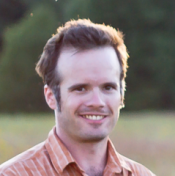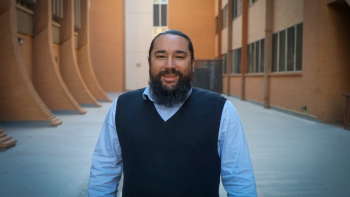3 ASU faculty members earn highest honor for early-career scientists, engineers
Three faculty in The College of Liberal Arts and Sciences at Arizona State University have been awarded the Presidential Early Career Award for Scientists and Engineers, or PECASE, by former President Joe Biden.
It is the highest honor given to outstanding scientists and engineers with young careers by the U.S. government.
Daniel Jacobs, Antia Botana and Gary Moore were selected this year for their contributions to their fields. All awardees are employed or funded by 14 participating agencies ranging from the Department of Agriculture to the Smithsonian Institution.
Established by former President Bill Clinton in 1996, PECASE recognizes those who show tremendous potential in their careers within science and engineering-related fields, and who have produced innovative developments in technology and research.
“These are exceptional achievements of our faculty and a testament to their outstanding contributions to science, technology and research,” said Kenro Kusumi, senior vice provost and dean of The College. “This prestigious award acknowledges not only their groundbreaking work but also their immense potential to shape the future of their respective fields.”
Daniel Jacobs
Daniel Jacobs, nominated by the National Science Foundation, was recognized for his work on developing an observation tool that has the potential to see the universe during its early years when stars were originally forming. The assistant professor from the School of Earth and Space Exploration is investigating this by looking at hydrogen in the 21-cm radio line.
“If you have a radio telescope that is sensitive to that wavelength, you can see it and it's visible throughout this sort of cosmic calendar. The wavelength that you can see this in is radiation that changes as the universe stretches the wavelength,” Jacobs said. “You can make a cosmic core sample all the way back from now to the beginning of time. Ultimately, it could potentially let us observe far before, say, the James Webb telescope or any other telescope could actually see.”
The specific telescope he uses as a project scientist and the lead of ASU’s contributions is the Hydrogen Epoch of Reionization Array based in South Africa, which is currently the largest, most sensitive 21-cm cosmology radio telescope. Jacobs also works on the Owens Valley Long Wavelength Array in California, a partner institution of ASU.
With this project, Jacobs also hopes to bridge gaps in the size of projects and instruments that are being funded.
“We're trying to raise awareness on this bigger issue of this gap in medium-scale projects and then come up with better designs for these telescopes that we want to build.”
Jacobs also currently serves as the associate director of the Interplanetary Initiative and the director of the Interplanetary Laboratory.
Antia Botana
Antia Botana, an associate professor in the Department of Physics, was nominated by the National Science Foundation for her work on superconductivity, a quantum state of matter whereby electrons move through a material without resistance, which is essential to different technologies ranging from magnetic resonance imaging machines to accelerators for high-energy physics.
However, the usefulness of these materials is often restricted by the low temperatures at which superconductivity usually emerges. Increasing transitional temperatures and discovering new superconductors is limited due to the uncertainties of what may cause superconductivity in different classes of materials.
“One of these classes is represented by copper oxides whose discovery in the 1980s had a profound influence on physics, as they could superconduct at a higher temperature than any material known at the time. Based on the proximity of nickel to copper in the periodic table, we have investigated nickel oxides to shed light on these questions,” Botana said.
She hopes to reach new superconductors with higher transition temperatures and expand what’s understood about nickel oxides to other classes of materials.
“It is an immense honor to receive the Presidential Early Career Award for Scientists and Engineers,” Botana said. “The research efforts this award recognizes have been supported by the National Science Foundation, so I am also very thankful for the nomination and the support of my research.”
Gary Moore
School of Molecular Sciences Associate Professor Gary Moore, nominated by the Department of Energy, was recognized for his work on energy conversion and fuel production. His research blends chemistry and inspiration from nature to create nanomaterials mimicking the chemical processes of living systems.
Specifically, Moore’s ASU research group is using sunlight to drive chemical reactions, with applications ranging from manufacturing fuels and fine chemicals to controlling essential bioenergetics.
“I am honored and thankful to receive the Presidential Early Career Award for Scientists and Engineers,” Moore said. “The research efforts this award recognizes are supported by the Department of Energy Solar Photochemistry program and made possible by the efforts of my research team, including current and past students in the School of Molecular Sciences.”
He has been elected to serve as the chair of the 2026 and 2028 Gordon Research Conferences on Electron Donor Acceptor Interactions.
More Science and technology

The Polytechnic School at ASU hits milestone mark at 10 years
The year was 2014.Taylor Swift released “1989.” "Frozen” and its soundtrack were stuck in the minds of many.Facebook was still the most popular social media site, and “Happy” by Pharrell…

Study finds cerebellum plays role in cognition — and it's different for males and females
Research has shown there can be sex differences between how male and female brains are wired.For example, links have been made between neurobehavioral diseases — such as attention-deficit/…

Artificial intelligence drives need for real data storage innovations
In southeastern Mesa, Arizona, construction crews are hard at work on a state-of-the-art data center. The $1 billion facility will open in 2026 and provide approximately 2.5 million square feet…


